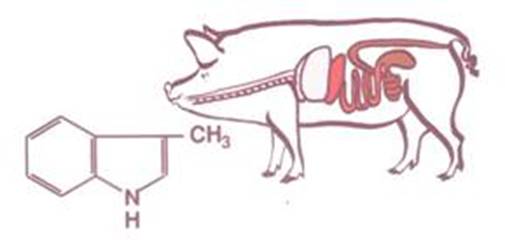Skatole
Skatole is a fermentation product produced by bacteria in the hindgut (large intestine) of the pig from the amino acid tryptophan. It is metabolized in the liver mainly by cytochrome P450 (CYP450). Un-metabolized skatole will accumulate in the back-fat (adipose tissue) causing boar taint. Pigs, that produce a large amount of skatole and express low levels of some specific enzymes in the liver will accumulate high skatole levels in fat. Reduction of skatole levels in fat can thus be achieved either by inhibiting its production in the intestine or by accelerating the metabolic rate. Because skatole is produced in the intestine of both males and females, the odour could be expected in both sexes, but according to Zamaratskaia et al. (2006) the difference is probably caused by sex-dependent differences in the potential to metabolize skatole. Only a few females develop the odour.
Skatole levels increase at puberty after the increase in the levels of testicular steroids. This is probably due to inhibition of hepatic skatole metabolism by androstenone and oestrogens, (Zamaratskaia and Squires, 2009).
Changes in dietary composition modify the microbial activity and therefore alter the rate of skatole synthesis in the intestine. The intestinal transit time is also affected by diet and thus influences skatole absorption from the intestinal walls. There have been numerous successful attempts to reduce skatole levels by altering feed composition and using dietary additives (Zamaratskaia and Squires, 2009).

Figure 6: Schematic illustration of the production of skatole. Source: Kerstin Lundström.